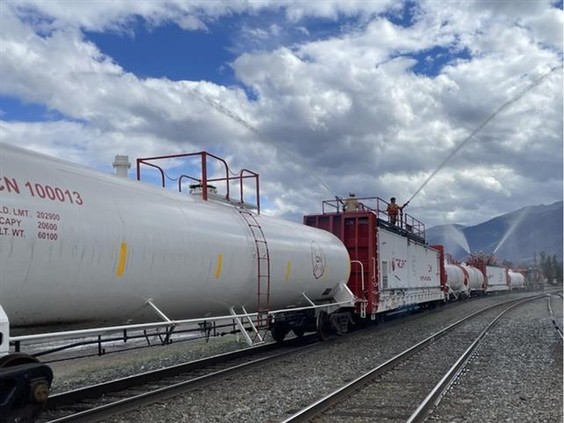
Michael Joel-Hansen
StarPhoenix
Canada’s major railways have been taking steps to protect their infrastructure at a time when extreme weather events such as wildfires are becoming more common.
Canadian National Railway Co. has developed three firefighting trains that can be deployed across its rail network to help combat wildfires.
The first of these trains to enter service was named Poseidon. Since coming online in 2022, Poseidon has been deployed 11 times. The two other firefighting trains, Trident and Neptune, were brought into service this spring and have been called into service seven times.
Matthew McClaren, vice-president of safety at CN Rail, said the process to construct the first train started in 2021. He said the trains have tanks that can store water and fire-retardant chemicals, and pumps that allow the water and chemicals to be sprayed onto areas around the track.
The firefighting trains are staffed by employees trained in handling wildfires and dangerous goods. McClaren said they can be sent all over the railway’s network.
“We dispatch them, deploy them across the network as needed,” he said. “We also have an amazing group of contractors and wildland fire specialists that we also deploy across North America as well.”
McClaren said the company works with a range of agencies and uses a variety of technologies to help determine where there is a high fire risk, aiming to have the trains positioned accordingly.
“CN was posted up in the unified command centre right there in Jasper, working with the parks and provincial regulators there in that corridor,” he said.
The wildfires forced CN Rail to suspend operations on its line through Jasper last week. The line is a vital one for the railway and many shippers in the country as it connects with shipping terminals at the Port of Vancouver.
The company was able to resume operations a few days later, after the line was inspected for damage. The company also consulted with Parks Canada in making its decision to reopen. McClaren added that deploying the train was one of the reasons the company was able to reopen the line after only a brief disruption.
McClaren said CN’s firefighting trains are in a unique position to combat the wildfires as railway rights of way in Canada are constructed in a way that makes them effective firebreaks. This allows the firefighting trains to make a major impact in battling some wildfires, he said.
“We can actually lay down water and retardant foam and proactively (stop) that fire from spreading from one side of our track to the other.”
CN Rail felt was important to develop the firefighting trains to protect its infrastructure, which the company recognizes are a critical part of the country’s supply chain, as well as wanting to be good partners in the communities where they are present, McClaren said.
The company is consistently monitoring severe weather events to make sure it’s prepared to respond if needed, he added.
“(Severe weather events) seem to be on the rise and we want to make sure that we’ve got enough assets to mitigate those.”
CN is not the only major Canadian railway that has developed firefighting capabilities. Canadian Pacific Kansas City Ltd. (CPKC) now has eight firefighting rail cars, which they call fire flats.
The trains include large tanks that can hold water, along with fire-retardant chemicals and pumps. A spokesperson said six of the cars are deployed in Alberta and British Columbia at the moment, while the other two are in the eastern part of the country.
“These assets are forward-positioned throughout the network in advance of the annual fire season and their positioning is evaluated regularly depending on risk and need,” a company spokesperson said in an email.

